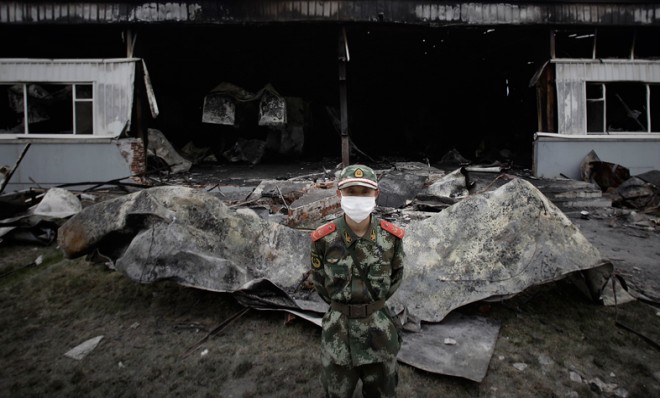China's nightmarish working conditions: By the numbers
Monday's deadly poultry plant fire calls attention to safety problems that kill tens of thousands of people every year


The fire that killed dozens of people inside a locked poultry slaughterhouse in China on Monday has renewed calls for improving the often appalling conditions for workers in the world's second largest economy. A small protest — quickly dispersed by authorities — broke out in front of the charred shell of the plant, and relatives of the victims demanded that plant managers answer for the disaster.
Labor experts said the tragedy reflected a long history of safety problems in Chinese factories. "Throughout China's modern economic development, there has really been very little consideration for the rights and interests of the workers," said Li Qiang, executive director of New York-based China Labor Watch. A numerical look at China's deadly industrial record:
70,000
The Week
Escape your echo chamber. Get the facts behind the news, plus analysis from multiple perspectives.

Sign up for The Week's Free Newsletters
From our morning news briefing to a weekly Good News Newsletter, get the best of The Week delivered directly to your inbox.
From our morning news briefing to a weekly Good News Newsletter, get the best of The Week delivered directly to your inbox.
Workers killed in China by workplace accidents last year — roughly 200 per day. That's down from 75,572 in 2011 and 79,552 in 2010.
119
People killed in Monday's fire, making it the most deadly factory fire in China's history. Many were trapped inside the plant because doors they could have used to escape were bolted shut.
70
A free daily email with the biggest news stories of the day – and the best features from TheWeek.com
Workers injured in the fire
3
Minutes it took for the flames to race through the plant after an explosion started the blaze
87
Workers killed in a fire at a toy factory 20 years ago — China's second most deadly factory fire ever. Doors at that factory were locked, too, allegedly to prevent theft.
281
Miners killed in a 2008 mining cave-in
2
Industrial fires in the five days before Monday's disaster. Two people died in the earlier blazes.
58
Residents killed in a 2010 high-rise apartment building fire caused by a welder working for an illegal subcontractor. Gao Weizhong, director of the local construction committee, was later jailed on abuse of power and bribery charges.
4
Workers killed in explosions of combustible dust at two Apple suppliers in 2011. Another 59 people were injured.
230 million
People in the migrant workforce, which moves to cities from the countryside, supplying much of the cheap labor fueling China's economic boom
676,541
Official estimate of China's cases of pneumoconiosis, a respiratory illness often caused by prolonged exposure to dust that builds up in the lungs, making it painful to breathe. "You can delay the progress of the disease through certain drugs and treatments, but... it is basically a death sentence," says Geoff Crothall, spokesman for the Hong Kong-based advocacy group China Labor Bulletin.
90
Percentage of those cases believed to be work-related. Many of the afflicted people worked at construction sites in boomtowns such as Shenzhen, where they inhaled dust while drilling or blasting holes at construction sites.
6 million
Top estimate of actual number of pneumoconiosis cases in China
11,000 to 21,000
Compensation (in dollars, equal to 70,000 to 130,000 yuan) some Shenzhen victims received after staging sit-ins that provoked public sympathy for ailing construction workers
10 to 20
Estimated percentage of pneumoconiosis victims nationwide who qualify for any kind of payout
30
Percentage drop in fatalities in China's coal mining industry last year after the most dangerous small operations were shut down, and mines remaining open got better safety equipment.
Sources: Agence France Presse, The Economist, NPR, Wall Street Journal
Harold Maass is a contributing editor at The Week. He has been writing for The Week since the 2001 debut of the U.S. print edition and served as editor of TheWeek.com when it launched in 2008. Harold started his career as a newspaper reporter in South Florida and Haiti. He has previously worked for a variety of news outlets, including The Miami Herald, ABC News and Fox News, and for several years wrote a daily roundup of financial news for The Week and Yahoo Finance.
-
 Zimbabwe’s driving crisis
Zimbabwe’s driving crisisUnder the Radar Southern African nation is experiencing a ‘public health disaster’ with one of the highest road fatality rates in the world
-
 The Mint’s 250th anniversary coins face a whitewashing controversy
The Mint’s 250th anniversary coins face a whitewashing controversyThe Explainer The designs omitted several notable moments for civil rights and women’s rights
-
 ‘If regulators nix the rail merger, supply chain inefficiency will persist’
‘If regulators nix the rail merger, supply chain inefficiency will persist’Instant Opinion Opinion, comment and editorials of the day
